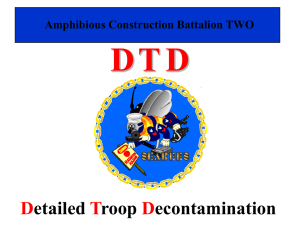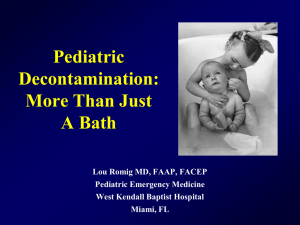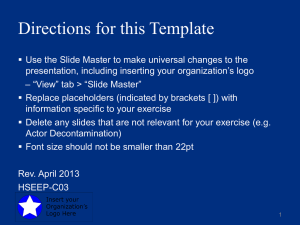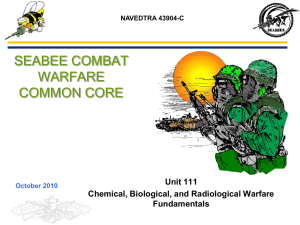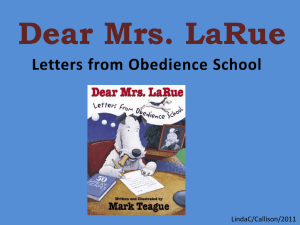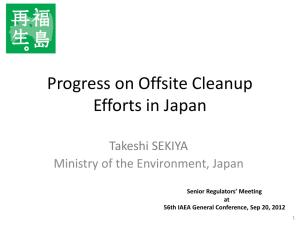Canine Decontamination Lecture
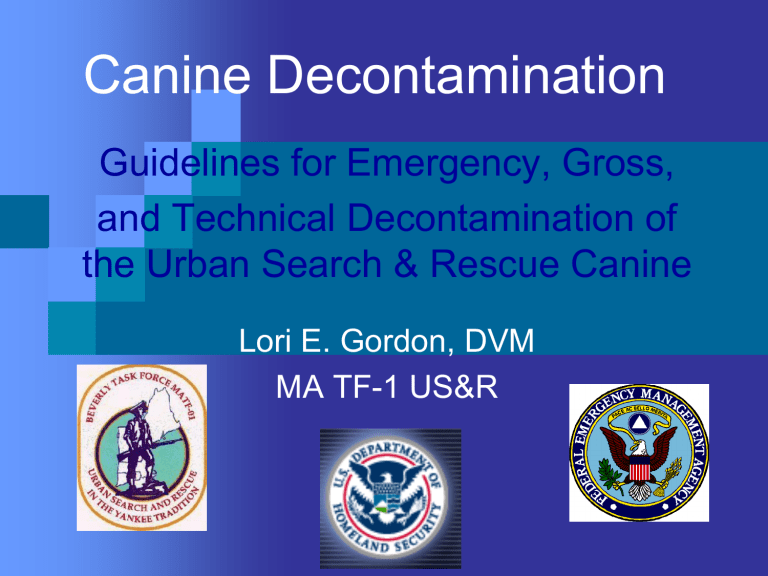
Canine Decontamination
Guidelines for Emergency, Gross, and Technical Decontamination of the Urban Search & Rescue Canine
Lori E. Gordon, DVM
MA TF-1 US&R
Why Decontaminate?
Canines exposed to multiple hazards during search
The toxicity to canines ranges from very mild (dirt, mud) to life-threatening
(chemical, biological, radiological)
They may also transmit hazardous materials back to others
Definitions
Gross Decontamination
Emergency
Non-Emergency
Technical Decontamination
Emergency/Medical
Non-Emergency/Medical
Gross Decontamination
Emergency = immediate reduction of contaminant for life-threatening conditions
Goal: save lives
Non-Emergency = bulk removal of non-life threatening contaminant
Goal: quick wash
Technical Decontamination
Emergency / Medical = HazMat or WMD situation, complete decon is part of life-saving medical treatment
Goal: save lives
Non-Emergency / Medical = complete removal of non-life threatening contaminant to avoid future complications
Goal: thorough decontamination
Treatment Before Decon?
Need, ability depend on several factors
Medical status (life-threatening?)
Medical personnel presence in hot/warm zone
On site medical supplies
Safety of personnel
Canine Factors
Routes of Exposure
Ambulation, Ground Proximity
Metabolism
Sensitivity
Toxicologic Agents of Concern
Physical Signs, Symptoms
Familiarization and Training
K9 Routes of Exposure
Ocular
Inhalation
Ingestion
Dermal
Injection
Ocular Route of Exposure
Situational Aspects
Lack of eye protection may interfere with mobility in tight spaces
Dust settles where they work
Sniffing aerosolizes particulates
Ocular Route of Exposure
Anatomical Factors
Canine similar to human
Treatments for injury and irritation uses same meds
Options
Eye rinsing
Protective environment during rest
Inhalation Route of Exposure
Situation: K9 more susceptible
Scent is their main search tool
No respiratory protection gear
Increased exposure to contaminants that concentrate on or near ground
Mouth also opens to take in scent
Inhalation Route of Exposure
Anatomical Advantages
Long length, intricate inner scrolled surface
Traps particulates before reaching lungs
Strong lung defense mechanisms and mediators of inflammation
Anatomical Disadvantages
Sensitive vascular mucosal lining
Absorbs contaminants into blood stream
Inhalation Route of Exposure
Options
Rinsing nasal cavity?
(Good luck!)
Dogs have their own solution – sneezing!
Sneezing as a command response
When small, hold puppy upside down
Fluid shift causes sneeze
Add command, response, reward
Ingestion Route of Exposure
Situational Aspects
Training emphasizes and rewards ignoring some tempting canine fun
Concern is hunger, or more importantly thirst, may override the best training and best trained
Ingestion Route of Exposure
Anatomical Aspect – The Tongue
Ђ Similar (but larger) to humans
Ђ Other purposes (pant, scent)
Ђ Potential damage if lick something harmful
Ingestion Route of Exposure
Behavioral Considerations
Dogs lick their body clean, especially after a mud stroll
Dogs lick their feet after a good ear scratch or face rub
Their tongue frequently rolls over nose and mouth
Debris collects on the tongue while out during panting, then is periodically ingested
Ingestion Route of Exposure
Options
Maintain adequate hydration
Periodic facial/body wiping/washing
Be observant
Dermal Route of Exposure
Situational Aspects
Without PPE, canine’s entire body is exposed and vulnerable
Anatomical Aspects
Advantages, disadvantages
Skin and fur
Ears, tail, and paw pads
K9 Anatomical Considerations
FUR
Different distribution and thickness than humans
Advantages
Trap particles, protect skin
Disadvantages
More difficult to decontaminate
Skin wounds harder to detect
K9 Anatomical Considerations
SKIN
Different blood supply than human
Advantages
Many areas protected by fur
Disadvantages
Other areas thin-skinned and delicate
Vulnerable spots: inner ear, nose, axilla, abdomen, inner flank, scrotum, paw pads
Does not blister; wounding hidden by fur
K9 Anatomical Considerations
EARS
Middle & internal similar to human, canal differs
Advantages
Floppy cartilages some protection to canal
Canal 90 o turn, adds protection to ear drum
Disadvantages
No ear protective equipment worn
Upright cartilage open to exposure
K9 Anatomical Considerations
TAIL
Unique expressive body part
Advantages
Behavioral monitor for humans
Just a note
Don’t forget the tail in decontamination
Hard to get to the underside and perineal area if it is tucked in tight
(A favorite greeting area ritual)
K9 Anatomical Considerations
PAW PADS
Unique aspect compared to humans
Advantages
Thick, tough pads protect
Disadvantages
Pads - hairless, sweat glands, will absorb nerve agents
Deep crevasses hard to decontaminate
High level of exposure without boots
Dermal Route of Exposure
Options
Periodic wipe, decrease contamination
Periodic hands-on body checks
Emphasize paw pad checks
Injection Route of Exposure
Situational Aspects
Nature of urban search is rubble - sharp objects, hazards increase risk of wounding
Lack of PPE increases risk
Wounds are entry into vascular system
Injection Route of Exposure
Anatomical and Behavioral Aspects
Wounds take the form of punctures, scrapes, burns, lacerations
Licking wounds adds ingestion exposure
Compromised tissue may be hard to detect or very obvious
Injection Route of Exposure
Options
Vigilance and frequent checks
Handler responsibilities
During search
Post search
Decontamination
Post-shift veterinary medical examination
K9 Ambulation,
Exposure Proximity, Risk
Working close to the ground:
Hazardous materials concentrate on ground, low surfaces
Chemical agents often dispersed as gases/aerosols heavier than air
Eyes, nose, mouth, paws subjected to constant exposure
K9 Metabolism
Aspects of the canine make this species both more susceptible to harm as well as more resistant to the dangers they may face during search
K9 Metabolic Considerations
Rate organs handle contaminants
Absorption via skin, respiratory tract, digestive tract into circulatory system
Filtering and altering through liver, spleen, kidneys
K9 Metabolic Considerations
Sensitivity and metabolism depend on many factors
Health status
Body condition
Age
Dose of toxin
Decontamination, treatment
K9 Toxin Sensitivity
Compared to Humans
Chemical Agents
Biological Agents
Radiological Agents
K9 Toxin Sensitivity
These comparisons are intended for risk assessment.
No matter their relative sensitivity to any agent, we treat the dog…not the agent
(other than specific antidotes)
This is especially important since we may not know the specific agent or contaminant
Chemical Agent Sensitivity
Nerve Agents
Tabun (GA)
¼ as sensitive to inhalation form
½ as sensitive to dermal form
Sarin (GB)
¼ as sensitive to inhalation form
2 times as sensitive to dermal form
Venom X (VX)
~ same sensitivity as humans to both forms
Chemical Agent Sensitivity
Blister Agents
Mustard (HD)
2 /
3 as sensitive to inhalation form
¼ as sensitive to dermal form
Blood Agents
Hydrogen Cyanide (AC)
4 times as sensitive to inhalation form
~ same sensitivity to dermal form
Riot Control Agents
CN, CS, OC
Quite insensitive to these
Biological Agent
Sensitivity
Bacteria
Anthrax - 500-1000 times more resistant
Typhoid - naturally resistant
Brucellosis - susceptible, zoonotic
Plague - intermediate host for flea transmission
Tularemia - susceptible but less sensitive
Biological Agent Sensitivity
Rickettsia
Q Fever – susceptible but less sensitive
Virus
Venezuelan Equine Encephalitis susceptible but less sensitive
Smallpox - canines naturally resistant
Biological Agent Sensitivity
Toxins – canine susceptible but less sensitive
Botulinim
Ricin
Staphylococcal
Enterotoxin B
Castor Beans Ricinus communis
Radiological Agent Sensitivity
Radiological materials emit ionizing radiation enough energy to alter cells
Forms of radiation
Alpha particles - dangerous if ingested
Beta particles - dangerous if ingested
Gamma - significant penetration
Neutron - cell damage on contact
Radiological Agent Sensitivity
Canines appear to be ~ 25% - 50% more sensitive then humans to the acute effects of the same radiation exposure
Due to lack of PPE, decontamination is an important aspect of treating exposure
Toxicological Agents of Concern
Some commonly encountered toxins in an urban search & rescue environment
Decontamination important for health of canine and all with whom they contact
Toxic Agents of Concern
Hydrocarbons
Gas, oil, trans fluid, toner, inks, adhesives
Ingestion/inhalation most harmful
Polychlorinated Biphenyls (PCBs)
Coolant, turbines, air conditioners, TVs
Dermal/oral exposure organ failure/cancer
Hazardous Metals
Chromium, cobalt, lead, mercury, nickel, zinc
Inhalation concern; wet coat, do not brush
Toxic Agents of Concern
Asbestos
Fireproofing, insulation, bind in pipes/cement
Inhalation concern; wet coat, do not brush
Soaps and Detergents
Industrial disaster, fire suppression foam
Cationics toxic: corrosive, pain, paralysis
Acids and Alkalis
Battery fluid, oven/pipe/toilet/drain cleaners
Corrosive, burns on contact or if inhaled
Toxic Agents of Concern
Ethylene Glycol
Antifreeze, deicer, solvents, brake fluid, inks
Sweet taste; ‘animal safe’ has bad taste
Mainly ingested
renal failure, neuro signs
Decon feet (licking), black light may show up
Propylene Glycol
Drugs, ink, antifreeze, deicer, resin, lubes
Rapid absorption if ingested
1 /
3 toxicity of EG: organ damage, sz, coma
Toxic Agents of Concern
Phenol
Resins, detergents, dyes, antiseptics
Caustic, absorption seizure, coma, death
Ingestion highly toxic
Alcohols
Solvents, intermediary chemicals
Problems if absorbed in large quantities
Documented Toxin Levels
New York Police Department working canines deployed to the World Trade Center, Sept 11-19,
2001
Fox PR, JAVMA Vol 233, July 2008
Prolonged exposure compared to brief exposure
Mean blood [lead] significantly higher
Mean serum [iron] not significantly different
Documented Toxin Levels
New York Police Department working canines deployed to the World Trade Center, Sept 11-19, 2001
Fox PR, JAVMA Vol
233, July 2008
Environmental toxins detected in serum of dogs in both prolonged and brief exposure groups
Quinoline
3-methyl quinoline carcinogenic, mutagenic
Isoquinoline
Diphenylamine
Surfynol
2-(1-phenylethyl) phenol
K9 Exposure Signs and Symptoms
Many signs of toxin exposure are common in canine and human
Other signs are more difficult to recognize or confirm
Recognized K9 Exposure Signs
Respiratory - cough, choke, gasp for air
Mucous Membranes - red eyes and gums
Ocular - tearing, pinpoint/dilated pupils
GI Signs - salivation, nausea, vomiting, diarrhea, abdominal cramping
Mentation - malaise, fatigue, disorientation
Neurological - twitching, seizure, paralysis
Hard to Recognize Signs in K9
Headache
Tightness in chest
Sweating axillae, inner flank, paw pads
Skin rash in places hidden by fur until advanced; may detect sensitivity by touch
Blisters due to different blood supply, skin forms burn-like wounds instead
K9 Familiarization and Training
Familiarization for both handler and canine will decrease stress, speed the process, and limit errors
Drills allow for decontamination stations to be set up and for canines to be run through them
Preventative
Measures
Preventative measures are worth far more than can be calmly expressed
Prevention – Skin, Fur, Pads
Minimizing dermal contamination and absorption
Bathing, rinsing, wiping coat decreases particle load
(baby wipes; inner ear, face, under tail)
Booties when not needed for traction
(familiarize at training, not on site)
Frequent body checks for cuts, abrasions; treat/protect early
Prevention – Eyes
Minimizing ocular contamination and absorption
Regular flushing of the eyes with 0.9% saline or purified water
(keep applicator tip clean, do not touch to eye)
Goggles, protective environment ( down time)
(familiarize at training)
Prevention – Nose and Mouth
Minimizing facial contamination and oral absorption
∞ Routinely wiping around nose and mouth
(baby wipes work well if available)
∞ Canines often use tongue to wipe these areas and toxin ingestion a real concern
Prevention:
Hydration
Maintaining adequate hydration
Maintains health, decreases medical issues - important in cold and warm weather
Decreases temptation to drink from a standing pool of liquid
potential disaster!
Encourage drinking bottled water - frequent small amounts, place low so won’t aspirate
Flavoring, hydration powders encourages drinking, does not significantly alter electrolytes
Hydration Guidelines
Maintenance fluids are ~2-4 ml/kg/hr,
(about 3 liters a day for an 80-90 pound dog)
Additional needs are based on the humidity, temperature, workload, and time worked
(intake may
1.25, 1.5, even 2X maintenance)
Periodic evaluation of hydration status is important (mucous membranes, capillary refill, skin tenting, dark/concentrated/infrequent urine)
Prevention – Work Rest Cycles
Adequate Work-Rest Cycles
Important aspect for canine health
Minimizes fatigue and medical issues
Maximizes search efficiency and safety
FEMA search K9 guidelines
Shift length of 12 hours
For every 20-45 minutes of work, rest for equal time period
Documentation of Acute Injuries
Reason for Preventative Measures
New York Police Department working canines deployed to the World Trade Center, Sept 11-19,
2001
Fox PR, JAVMA Vol 233, July 2008
Fatigue 62.9%
Conjunctival irritation 62.9%
Respiratory problems 16%
Dehydration 13%
Cuts and abrasions 12%
Decontamination
Principles, Procedures, Goals
Basic Decontamination Information
Human Safety in Decon Line
Going Through the Line
Decontamination Corridor
HazMat Concerns: Chemical,
Biological, Radiological
Petroleum-Based Contaminants
K9 Decon Basics
Canine
Decontamination
General Principles for the
Removal of Contaminants
K9 Decontamination Basics
Consult references if possible
Books
Material Safety Data Sheet (MSDS)
Emergency Response Guidebook (ERG)
Small Animal Toxicology & Poisonings by Gfeller, Messonnier
Telephone
Animal Poison Control Center (APCC) 888-426-4435 , $60
National APCC @ University of Ill 800-548-2423 , $30
ChemTrec 800-424-9300
National Response Center 800-424-8802
Internet
• CDC and ATSDIR @ www.bt.cdc.gov
CBRNE @ www.bigmedicine.ca/toolsGregoryBanner.htm
K9 Decontamination Basics
Powders
Initially wipe off with moist towelette
Avoid brushing - aerosolizes contaminant, increasing inhalation exposure
Thick Caked-On Substance
Break down mechanics’ soap, mineral oil for petroleum-based, or scrape with putty knife
Clippers rarely last, use scissors with caution
(laceration potential)
K9 Decontamination Basics
Physical removal of contaminant
Water - lukewarm, high vol, low pressure
With soap in 3 rinse-soap-rinse cycles
Dish soap (Dawn
Shampoo (Prell
50:50 with water or Joy
less soapy)
– less soapy, easier to rinse)
High pH neutralizes, dissolves
Decon head to tail, shoulder to forelegs, back to belly, hips to hindlegs, under tail, paw pads
Note: some hazardous materials become reactive when exposed to water; check 2008 ERG pp 342-347
K9 Decontamination
Basics
Eyes
Small bottles OTC ophthalmic rinse ideal for gentle but steady flush stream
Uncooperative?
Remove as much as possible around eyes with towelette, flush at vet check
Do not apply eye ointment until vet check
(Traps contaminant, absorption, worsens corneal damage)
K9 Decontamination Basics
Avoid soap into eyes, nose, mouth
High pH damages mucous membranes
Neutral soaps nice but less effective in neutralizing chemicals
Soap and water in ears promotes vigorous shaking
(don’t forget your eye protection!)
K9 Decon Special Considerations
Chemicals that worsen if exposed to water
Apply baking soda/flour to form cake, then brush/comb or wipe/brush
Paw pads need special attention
Deep crevasses trap particles
Soft-bristled brush (BD E-Z Scrub 160)
Eye flushing for 15 minutes
Important for blister, blood, and metabolic agents of concern (mustard, Lewisite, arsine, cyanide)
K9 Decon Special Considerations
Bathing K9 in 0.5% hypochlorite
Dilute bleach solution, follow with soap/water
For blistering agents and flood water decon
Dermal exposure to phenols
All personnel wear gloves, gowns, masks
Blot fur and skin with paper towels before washing
Never use hydrocarbon-based solvents to decon an animal
Defats the dermis Painful!
Increases absorption of toxins (PCBs)
K9 Decon Special Considerations
Contaminated Run-off
Do not allow canine to drink decon run-off
Elevate canine or provide for drainage
Basket muzzles won’t stop, can’t decon face with regular muzzle
Weather conditions
Fans, shade, shelter to avoid hyperthermia
Dryer, heater, shelter to avoid hypothermia
K9 Decon Special Considerations
Post decontamination checks
HazMat safety check
Visual inspection
Black light
Radiation detection
Veterinary check
Complete physical examination
Treatments, follow-ups as needed
H
uman Safety in the
Decon Line
Safety Officer, HazMat Specialist,
Command Staff all contribute to decisions on PPE
Additional conditions, like heat stress and hypothermia, are also factored into these decisions
Human Safety PPE
PPE for those working the decon line should be not more than one level less then that of who they are decontaminating
Same principle applies to canine decon , as if they had PPE, despite the fact they are not wearing any
Waterproof over-garment if using less than Level A or B
Human Safety PPE
Boots
Knee-length rubber boots, slip-resistant soles
Gloves
Nitrile, polyvinyl chloride gloves are good protection, durable, resist tearing
Double-gloving with outer heavy glove
Human Safety PPE
Eye protection
Tight fitting goggles against splash hazards
Safety glasses not protective enough
Respiratory protection
N-96 Particulate respirators protect from spray mists
Other as deemed appropriate by safety/HazMat
Human Safety – Physical Strain
Back & knee injuries common when dealing with animals
Decontamination procedures may require much bending, back/knee strain
Consider proper posture, knee-pads, raising a platform upon which the canines stand for their decontamination
Going Through Decon Line
Medical Assessment
Preparation
Rinse - Wash
Drying
Antimicrobial Station Option
Monitor, Treat, Return to Service
Going Through Decon
Assessment:
Emergency or Non-Emergency
Emergent, contaminant not life threatening: gross emergency decon, medical attention
Emergent, contaminant removal part of treatment: technical emergency decon, medical attention
Non-emergent: gross and/or technical decon performed based on contaminants involved
Going Through Decon
Handler should accompany canine
If unable , another experienced handler best
If canine cannot be taken safely without handler, confine to contain contamination
If handler needs decon , confine canine until handler clean, dons PPE, can take through
Handler unavailable , no other can, confine, consult for options: gross decon in kennel, sedation
Going Through Decon
Preparation
Remove K9 equipment/gear to container
Cleanse (bleach), dispose
Maintain control , stay in corridor confines
So as not to spread contaminant
Muzzle for safety, prevent drinking ?
Basket versus nylon, pros and cons
Going Through Decon
Rinse – Wash Cycles
Initial gross decon water removal of bulk of contaminant ( powder, water-reactive, caked)
Wipe/wash head/face, inner ears
Eye flush if practical
Wash - rinse X 3 head to tail back to toes
Going Through Decon
Drying
The body shake inevitable
Weather-related pitfalls
Warm weather hyperthermia: shade, fan
Cold weather hypothermia: shelter, dryer
Going Through Decon
Antimicrobial Station Option
For suspected biological contamination
Spray, bathe, or walk through solutions
Hypochlorite (bleach) @ 100-500 ppm or 0.5%; rinse afterwards
Biguanide (chlorhexidine) @ 0.05-4%
Quarternary ammonium @ 400 ppm or 0.1-2%
Iodophore (povidone-iodine) @ 100 ppm
Peroxygen @ 20 g/L or 1%
Alcohol (ethyl, isopropyl) @ 70%
Going Through Decon
Monitor, Treat, Return to Service
Monitor for contamination
Special check of eyes, ears, nose, throat, paws, under tail
Repeat decon if need, new collar/leash
Complete veterinary exam, treat, monitor
Return to service
Decontamination
Corridor
Stations, modify as needed
Equipment Removal Station
Washing Station
Rinsing Station
Antimicrobial Station
Drying Station
K9 Decontamination Corridor
Hot Zo ne to Cold Zo ne
Drop Washing Pool Rinsing Pool Foot Bath Drying Area Vet
Bucket Check
HazMat Specifics
Chemical Exposure
Biological Exposure
Radiological Exposure
Chemical Exposure Decon
Remove
Relocate to ventilated upwind area
Remove, replace gear
(metal, nylon)
Liquid: pinch/blot, not rub
(just spreads)
Powder: dampen, then remove
(brush, wipe)
Wash
High volume, low pressure lukewarm water
Don’t delay for lack of soap or warm water
Monitor
Veterinary evaluation, monitor, recheck
Litmus Paper Monitoring
Litmus strip on left
Moistened in bottled water
Pressed onto human forearm skin
Read out pH 6.0
Litmus strip on right
Moistened in bottled water
Used as control
Read out pH 5.0
Litmus Paper Monitoring
Litmus strip on left
Moistened in bottled water
Used as control
Read out pH 5.0
Litmus strip on right
Moistened in bottled water
Pressed to K9 abdomen, ear
Read out pH 8.0
Biological Exposure Decon
Remove, Wash, Monitor as for Chemical
Concern is likely to go unnoticed until symptoms develop
Good news – dogs resistant to most biological weapons
Bad news – they can still be vectors, so decontamination important
Radiological Exposure Decon
Remove, Wash, Monitor as for Chemical
Alpha radiation masked by water, so thorough drying before monitoring
Careful not to aerosolize particulates
(
and
)
Petroleum-Based
Contaminants
‘Like Dissolves Like’
A method for decontamination of oil-based substances was tested and confirmed at drill
MA TF-1 Drill: Oil-Based Decon
Test Material: oil-based non-toxic product
Glo Germ
Glo Germ
Powder Liquid
Canine
‘Contamination’
Drill: Soap and Water Decon
Soap/water decon
Attention to paws
Confirmation of contamination
Paw still contaminated after soap & water
Drill: Like Dissolves Like
Mineral Oil sprayed onto paws
Pre-decon
Contamination
Post oil-soap-water
Complete decontamination
Decontamination
System Designs
Canines in a Human System
Canine-Design System
Field Test
K9 in Human Gross
Decontamination System
Enter after initial blotting of visible contaminate.
Wash as long as deemed appropriate by staff.
K9 in Human Technical
Decontamination System
TVI Technical Decontamination System
K9 Addition to FEMA US&R
Decontamination Floor Plan
National Urban Search & Rescue Response System
600 gal
Waste
Bladder
Generator Weapons of Mass Destruction
Water Source
Generator
Decon Setup Diagram
Water Heaters
Manifold
Warm Water
KD Canopy 10 ’ x 20”
Cold Water
Gross
Decon
Gross Decon
Showers w/1 ” inlets
& 1 WW Pump
Tube Lights
Sump Pump
K-9 Corridor
Three lane modular scrub and rinse tent
Decon Tent
K-9 Corridor
Doff Area
Tube light
3-KD Canopies 10 ’ x 20”
Personal
Shower
3 gpm Shower
Sump Pump
Tube light
DOFF Tent Redress
Male
Personal
Shower
3 gpm Shower
Sump Pump
Tube light
DOFF Tent
Spill blocker dike
Redress
Female
Tube light
Medical &
Rehab Tent
Electrical
Cold water
Warm water
Waste water
Tube light
Sump pump
SCBA Rinse Barrels
Light
Waste barrel
SCBA Drop off and rehab
Light
Tube light
Donning Tent
KD Canopy 10 ’ x 20”
Mod 4-38
Canine System
Design
MA TF-1 US&R system development for search canine decontamination unit
MA TF-1 K9 Decon System
Materials and cost (2007/2008)
TVI Corp www.tvicorp.com
2 TVI canine pools@ $400 ea $800
Home Depot 4 plastic shelving units $ 70
Home Depot/Lowes Sump pump for waste removal $ 70
Dri Dek: www.dri-dek.com
12 DriDeck 12”x12” panels $ 60
Local hardware store
Local hardware store
2 lengths of rope
Plastic cable ties
Local hardware store
Local hardware store
1 plastic sheet
2 Hoses
Local hardware store Wash Hose & Wand
$ 5
$ 5
$ 10
$ 20
$ 25
MA TF-1 K9 Decon System
One shelf unit
Light-weight plastic
TVI Pools
Hose ports for run-off
MA TF-1 K9 Decon System
Non-slip flooring Altered shelf unit
MA TF-1 K9 Decon System
Corridor boundary guide
MA TF-1 K9 Decon System
Pool assembly Shelf placement with plastic over-sheet
MA TF-1 K9 Decon System
Search canine ‘Uber’ checks out the system
MA TF-1 K9 Decon System
System Advantages
Inexpensive <$1100
Light weight 47 lbs/21 kg
Compact pools 4’x10’, shelves 2’x3’x1.5’
Durability low cost to replace parts
Easy to assemble 10 minutes
Reusable
MA TF-1 K9 Decon System
System Advantages
Contain run-off port holes for hoses
Personnel safety knees, lower back
Better K9 decon easy reach paws, belly
Contaminated water out of reach
PPE suit protection no kneeling/tearing
Canine System
Field Tested
Human remains search conducted after fire with additional asbestos and other hazardous materials
K9 Decon System Field Tested
Gloucester Fire HRD Canine Search
K9 Decon System Field Tested
Decontamination Water Heater
Tent
K9 Decon System Field Tested
Canine Decontamination
K9 Decon System Field Tested
Comments
State trooper’s canine did well
A little wobbly on the platform
Familiarization training needed
One pole broke at base, taped
Tent also had heat to decrease hypothermia potential
K9 Decontamination Kit
General Equipment
Human PPE
Decontamination Supplies
Canine Supplies
K9 Decon – General Equipment
Box Container
Waterproof tarp
Buckets
Water heater
Industrial plastic bags Pools
Hose Shelving
Spray nozzle, wand Shallow pan
K9 Decon - Human PPE Equipment
Eye protection goggles
Gloves nitrile, polyvinyl, +/- overglove
Masks particulate
Tyvek suits or situation equivalent
Rubber boots knee length, overboots
K9 Decontamination Supplies
Absorbent Item baking soda, cornstarch
Liquid Soap Dawn
, Joy
, Prell
Dog Shampoo reestablish coat
Mineral Oil dissolve petroleum-based
Spray bottle easier min oil application
K9 Decontamination Supplies
Scrub brushes BD E-X Scrub 160
Eye rinse saline, purified water
Moist towelettes baby wipes
Large absorbent towels
Canine Supplies
Leashes disposable, double for collar
Fans drying, prevent/treat heat stress
Dryer drying, prevent hypothermia
Emergency blanket
Scissors use with caution
Muzzles nylon, basket
References
www.usarveterinarygroup.org
www.avma.org/avmacollections/disaster
www.aspca.org
Protection, Decontamination, and Medical Aid for K9 Teams (EAI Corp)
US&R WMD Enhanced Ops (FEMA)
Thank You
A dog can make you better
Than you’ve ever been before
You ask them for their all and then
They give you so much more

